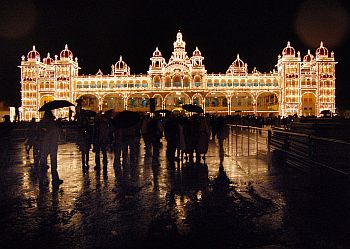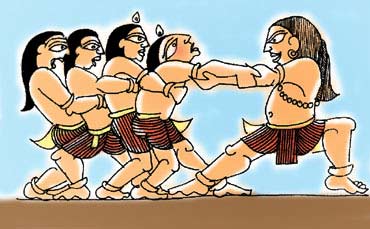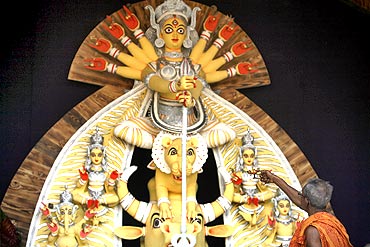 | « Back to article | Print this article |
Four Dussehra stories from mythology
Each year, the festival of nine nights or Navratri concludes with Dussehra. Here are four (of the many) reasons we celebrate this festival.
The tenth day of the Hindu month of Ashwin is celebrated as Dussehra. The festival is celebrated not just across India but also in the neighbouring countries of Nepal and Bangladesh too.
This also marks the beginning of the harvest season with farmers praying for a rich crop. Perhaps a lesser-known fact is that the day is also observed as the Vishwakarma Divas or a Labour Day of sorts, which is why you worship everything that helps you in your day-to-day activities -- be it books, kitchen knives, spades, even vehicles!
At its very essence though Dussehra is the victory of good over evil and like every other festival has lots of legends attached to it.
Here are four such stories!
Lord Rama kills Ravana
The theme of the triumph of Good over Evil is a recurring one in Indian mythology. Scores of stories exist amongst the thousands of pages of scriptures where the Good triumphs over Evil.
The one that towers over them all, however, is that of Ravana's death at the hands of Lord Rama.
According to legends it was on this day that Rama, an incarnation of Vishnu killed the demon king and brought his abducted wife, Sita back home.
This is also the reason why effigies of Ravana, his brother Kumbhakarna and son Meghanad are burnt in various parts of the country.
The day also marks the shift in season -- from harsh summer to pleasant and cold winters.
It is said that Lord Rama, his brother Lakshmana returned with Sita to Ayodhya about 20 days after Dussehra. The city of Ayodhya was lit up with thousands of earthen lamps to welcome their lord. On this day we celebrate Diwali.
Pandavas end their Agnyatwas
After losing everything they ever owned in a game of dice, the five brothers were exiled by their cousins, the Kauravas, to 12 years of living in the forest (Vanvas) and one year of living incognito.
They spent the 12 years living in various forests and in the final year -- after hiding their divine weapons in a hole of a Shami tree -- decided to live in the Kingdom of Virat.
The five brothers and their wife spent the year in disguise but as the kingdom faced an attack from the Kaurava army, the brothers shed their disguise, went back to the Shami tree and for the first time in a year took their weapons in their hands on this day.
In the battlefield, the Kaurava army was routed and the battle was the first in the chain of events that would eventually lead to the war of Kurukshetra.
Illustration courtesy: Dr Devdutt Pattanaik from his book Jaya: An Illustrated Retelling of the Mahabharata
Goddess Durga slays Mahishasur
Yet another story of demon slaying!
In the eternal war between the demons and the gods, one particular demon or asura managed to create havoc on earth and even managed to defeat the gods.
As he tyrannised the world, the gods combined their energies and thus was born Goddess Durga.
The goddess was blessed with ten hands and the many gods armed her with weapons to help her slay the demon Mahishasur.
Legend has it that the battle between Durga and Mahishasur raged on for nine days and nine nights and finally on the tenth day, Mahishasur was defeated and killed.
Kautsa's Gurudakshina
Another legend, that has nothing to do with demons or battles, tells the story of Kautsa, a young bramhin boy who insisted that his guru -- Rishi Varatantu -- accept Guru Dakshina, a fee of sorts for all the things he taught him.
While the teacher refused to accept any fees, the disciple was persistent. Finally Varatantu asked him to give him 140 million gold coins in return for the 14 sciences that he taught the young boy.
So Kautsa went to King Raghu, who was known for his generosity.
As luck would have it, the king had just spent his money donating to bramhins. So he asked for three days from Kautsa and left to ask for the coins from Lord Indra.
Indra in turn asked Kuber, the lord of wealth and asked him to rain gold coins on the Shanu and Aapati trees round King Raghu's city.
Sure enough it began raining gold coins, which King Raghu handed over to Kautsa who in turn offered to his teacher. Since the sage Varatantu had only asked for 140 million, he returned the rest to his disciple.
Kautsa returned the wealth to the people of Ayodhya on the day of, you guessed it, Dussehra.
The practice of distributing leaves of the Aapati trees has its roots in this legend.
Illustration: Uttam Ghosh




